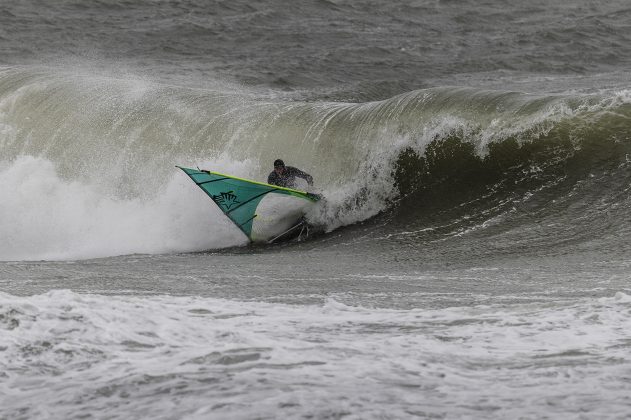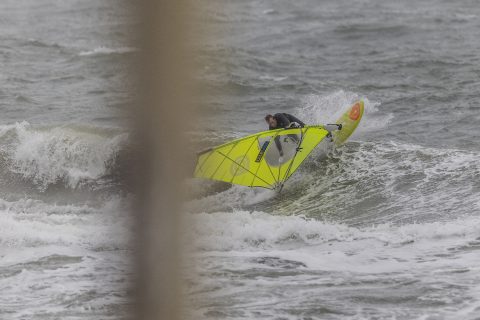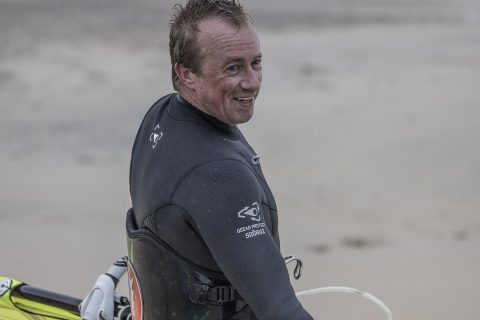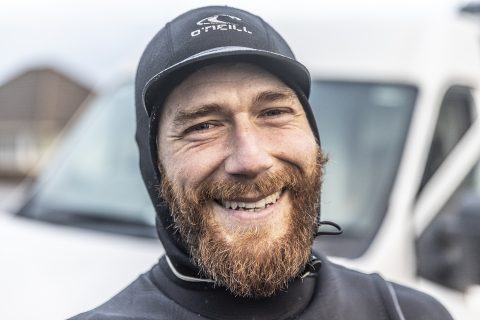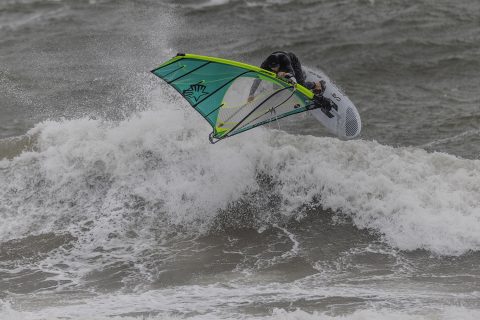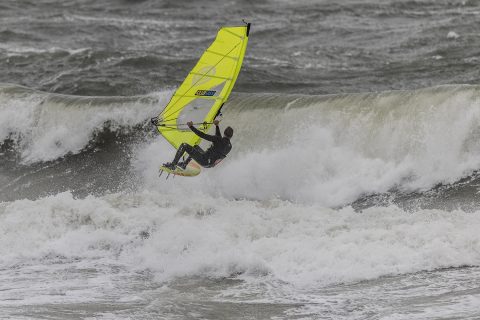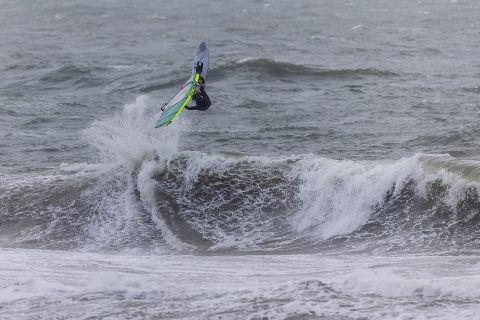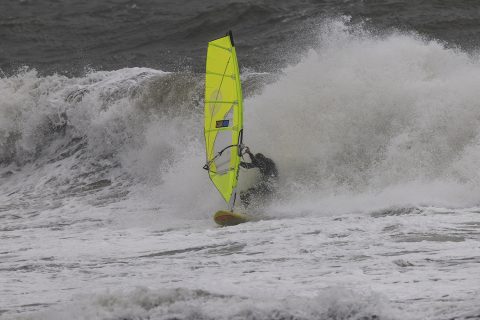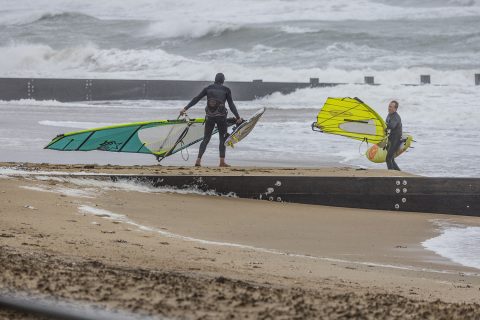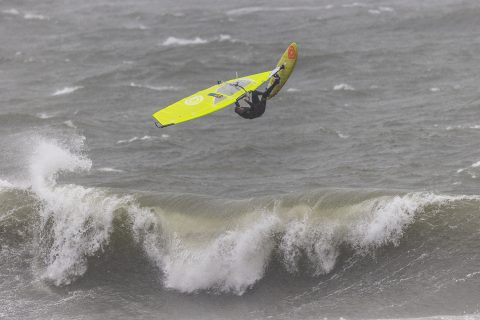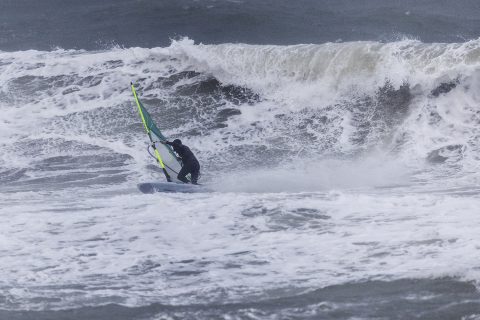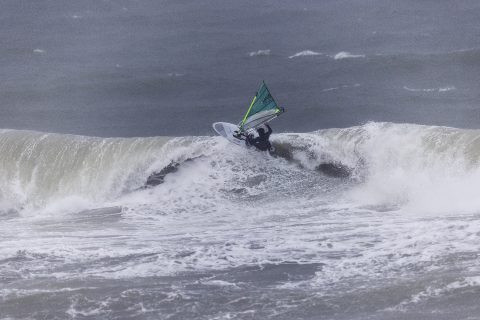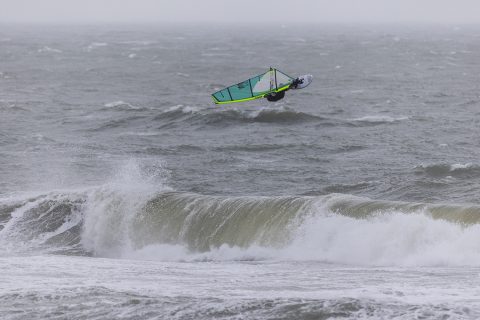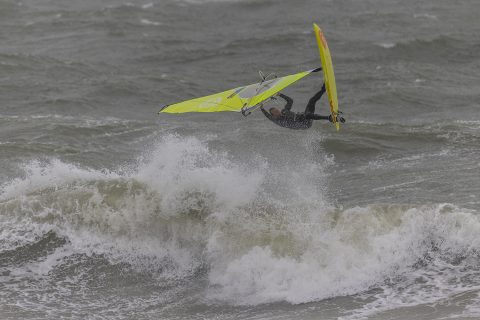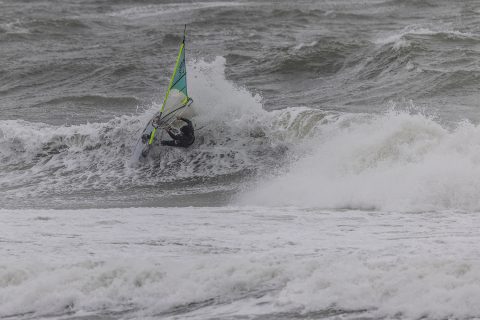SOUTHBOURNE: THE GOOD, THE BAD AND THE GNAR!
James Cox and Andy Chambers recount a wild, winter’s day at their home spot of Southbourne on England’s south coast. It’s a beach with a reputation for heavy waves and the pair reflect on the good and bad of sailing in gnarly storms there!
Words: Andy Chambers, James Cox // Photos: John Carter.
Comradery
Andy Chambers: “Windsurfing is a very social sport and it is always a lot more fun when you share the big days with others! I met James Cox through windsurfing before I moved to the area, so it was great that I knew someone who shared the same passion when I settled here at Southbourne. I think after the first lockdown we realised how much windsurfing brings people together, as we didn’t see each other for ages, but then on the first windy day it was awesome to catch up and go for a windsurfing session. Locally we have a Facebook group called Avon Beach Surfers, where all the local windsurfers keep in touch and we also have a WhatsApp group.
- Andy backside
To be honest though, you know that whenever it’s going off, or there’s a big storm at Southbourne, you will find ‘Coxy’ there. Some days he definitely needs a wingman, especially when the conditions are gnarly like back in January! Southbourne can be a fairly brutal place to sail during the winter in the UK, especially when it is gale force with chunky waves. It is almost reassuring to have someone else out on the water with you, just to watch your back if nothing else. Sailing with ‘Coxy’ definitely helps to motivate me to try and go bigger because he never holds back!”
- Andy Chambers
James Cox: “I saw a picture in an old magazine recently of Bubble and myself on Tiree and thought, ‘Gee, we’ve been windsurfing together for a long time!’ And that is pretty cool. Windsurfing friendships are special in so many ways, but it’s that continual shared experience that keeps the sparkle in our eyes. Although I don’t seem to be going out for so many beers these days, I love that social element of windsurfing. You probably know Bubble had an illustrious history in freestyle competition before starting to compete in the UK wave series, and that was when we first started windsurfing together. It’s always been very motivational seeing what he does, bringing his style and ability to the wave arena. The result is that he absolutely shreds and inspires me to up my game and think harder about things I’m stuck on. It’s a bit like windsurfing with an instructor; I can watch him to see what I need to do.
- James Cox
Even though I consider myself a reasonably functioning human adult with middling social skills, sometimes I have a tendency to be a bit of loner when it comes to windsurfing. Perhaps instilled in me from my university days in the Gower, Wales, where the beach was often empty. As a result, I enjoy both social and lone windsurfs, but given the chance I’d choose a session with my chums. It’s nice to chat things through on the cliff with Bubble before and after. Both to check whether it’s a terrible idea going out and then confirm afterwards that it was a terrible idea going out.
Out on the water the best outcome is probably each of us seeing each other getting nailed by a set wave and kit and the owner surviving. If that happens early on in the session, that inspires confidence and ups the game; 99% of our post session chat is about the maulings that we experienced. It’s just the most fun and interesting part. Even better if you get to witness it first-hand. So in heavy sessions the comradery is best because we are both the underdogs trying to sneak doggy snacks from underneath the master’s nose.”
- Coxy backside air
Options
Andy Chambers: “On certain days you have the option to sail either more mellow Avon or savage Southbourne. The tide makes a massive difference at both spots so usually I will sail Avon for a bit and when conditions deteriorate head round to Southbourne or vice versa. The attraction of Southbourne is the raw power and gnarly factor for sure. You can get bigger jumps and more reward when you make a late hit on a nasty section! It is also pretty humbling, especially if you’ve been at Avon feeling like you have been sailing really well. Then on your first run out at Southbourne you take a closeout beast on the head and get drilled into the sandbar so hard you end up with sand inside your wetsuit!”
James Cox: “Sometimes I wonder what the best thing to get me out of bed in the morning is, because it sure as hell isn’t the thought of going to work; I think I’ve worked out it’s probably nervous energy that comes on the morning of an impending windsurfing challenge. If I know the challenge is on at Southbourne, it’s hard not to consider it because I know from experience the feeling afterwards. I do like to sail Avon as well though; you see more people out there and it’s more likely I’ll learn something at Avon in those sort of conditions because you get more time to plan out moves and recover if you crash.
On this particular day at Southbourne, it was probably at the size limit of what I consider ‘fun’, but something to do with the heaviness and speed of which it was breaking meant that I came away feeling like I hesitated too often, i.e. there was opportunities to hit the lip that I didn’t take. But wave riding is a little like two steps forward one step back sometimes.”
- Heading through the chaos
Navigating the chaos
Andy Chambers: “When there is so much water moving, and foam to try and get through, you lose a lot of power from the fins as the water is so aerated. You might have plenty of power in the sail, but it still feels like you are dragging a bucket behind you. It is a strange feeling and quite often can cause you to get caught out by a mast-high bomb whilst not planing. I found that if I head upwind and gybe super close to the beach to give myself the longest run up possible with lots of speed, that helps me to navigate my way through all the turbulent water. I also try to pick the smoothest route out so I have plenty of speed to hit the big ramp on the sandbar. If you try to get going in the whitewater section, you are most likely doomed!”
James Cox: “I actually catapult a lot at Southbourne. Part of the reason for this is that the window of opportunity to jump is quite narrow, so you need maximum board speed to be maintained through the whitewater and mid-sized waves to make the most of it. But being hooked-in at maximum speed through waist-high chop and whitewater turbulence, all while trying to point upwind, can end up with some interesting wipeouts. The most common reason for catapulting is the board sliding in a foam pocket from a previous wave.”
- James Cox takes off
Gear choice
Andy Chambers: “Normally when it is blowing gale force, I take the smallest gear I have! If there is a lot of whitewater, I keep the sail small, but rigged with a bit less outhaul to try and help me get going quicker on the inside. Occasionally I will go a little bigger on the board as the wider tail helps to stop it sinking in the turbulent whitewater.”
James Cox: “The smallest gear when it is wild, always!”
Storm force
- Dealing with strong winds
Andy Chambers: “I like the longer runs you get when the conditions are wild as there are more opportunities to set yourself up for jumps. Also, you can wave ride both backside and frontside when it is side-onshore. It is always fun to mix things up! Generally you are closer to the beach as well, so if anything goes wrong, the swim in is not so far.
The rain, poor visibility and cold do not bother me so much. If the conditions are pumping, there is not much that will stop me going out! However the horizontal rain hitting you in the face like needles isn’t the most fun! A hooded wetsuit definitely helps!
Southbourne is pretty heavy especially at low tide. Up to half-mast it’s ok to hit it late, but as soon as it gets to logo or mast your timing has to be perfect or you can get pummelled. The wave really dredges the sand up off the bottom, so I feel like that adds to the power. I definitely get scared when it is over logo high!”
- Heading out
James Cox: “I agree with Bubble on all counts. Generally when it’s wild and a bit cross-onshore, there are more opportunities open to you. Plus the benefit of an onshore wind oriented beach is that it often gets bigger waves.
Sailing in big storms is a challenge I am constantly working on, it’s frightening and unless you’re somewhere near flow state it might not be a good idea. There is a wave type (combination of height, direction and period) where it might not be makeable for 99% of windsurfers and I am not in that 1%. So each day is a judgement call based on how quickly it’s breaking and how much water it is sending over the bar. Interestingly on this day it was high tide, yet it was only just over head deep in the impact zone. Luckily it is sand after all, I know that because I have been pinned to the bottom and dragged around on it numerous times. It’s an interesting point Bubble makes about the sand content of the lip. I hadn’t thought of that. Chemically that’s only one step away from concrete right? Sand, water and… lime? I don’t know, but the water does hit you hard. Come to think of it, Oscar Shaw, who was also out there, deserves a mention, he did really well! I think it was one of his first days at Southbourne. He turned up (like JC pretty much) in pyjamas and got stuck in to one of the gnarliest days of the year!”
Motivation
Andy Chambers: “It is very motivating to see riders like James Cox nail something sick whether it’s a big jump or wave move. Even the wipeouts help as it gives you more confidence to go for it when he emerges unscathed!”
- Andy Chambers back loop
Storm sailing tips
Andy Chambers: “I always try to go earlier at the lip than on a normal wave when it is cross-onshore and gnarly! I put my back hand right down the boom and try to get the board more vertical so that the lips smacks your board around rather than straightening out and getting clobbered. The faster you are going the easier it is to hit the more critical section. If you think you are too late, then turn more vertical into the lip.”
- Bottom turn from James Cox
James Cox: “Hold the sail firmly when you get to the top of the wave. You’ll be bottom turning in an area of not much wind and when you get to the top the sail may or may not fill with a force 8 gust! Backside riding can lead to longer rides at Southbourne, plus you get an upwind advantage for your next run out. Also, it’s possible to be quite expressive with turns upwind and stay close to the lip. The wave often filters out the wind, so if you lay your sail down you are almost just using the board to carve.”
- Coxy smacks the lip
Rainy days
Andy Chambers: “I was surprised JC turned up without any waterproof gear, considering the forecast! He managed to find a pretty good sheltered spot to take pics from though. I suppose I could have lent him my ExoRobe, which would have kept him warm and dry, oops! He also seemed to think there was always a clear patch in the weather on the way, which strangely never arrived! We called it the JC jinx; I have heard others call him the black cat!
Then I heard he caught a train home headed the wrong way away from Southampton. That is typical JC! It is easily done though, especially if the person who gave him a lift to the train station dropped him off on the wrong platform, not mentioning any names…James Cox!”
James Cox: “It was the perfect end to the day in my eyes, let’s just say that. Add to the fact he took a train in the wrong direction and also missed his ferry! JC has an exceptional ability to deftly tell hilarious stories of misadventure. I have almost wet myself laughing at these in the past. Philosophically speaking, if a mission goes so far wrong that a hilarious story is the result, has it not just gone so far wrong that it’s actually gone right? Let’s just think about that for a moment…”
- James flying high
Wild and windy
Andy Chambers: “To be honest, it does feel good after a wild stormy session is finished; you’ve survived and you can reflect back on it. Sometimes during the session it doesn’t feel good though! It’s good to push your limits and take a beating so you know what you can handle. It means that the next time you will have more confidence to go for it more. I definitely miss the wild winter days during the summer, as we don’t get much swell unless it’s a big storm, and those storms are a rarity. That’s one of the best things about windsurfing year-round in the UK is the variety of conditions. We have the winter for wild storms and then when that season is over we can mess around with freestyle, foiling and freeriding in the sea breezes.”
- Andy airs the section
James Cox: “I agree with Bubble, it definitely feels good sailing in storms and sometimes I can be happy to just be out there playing chess with the elements, feeling the force of what’s around me and return with kit intact. Sometimes I like to engage more with it. It allows you to gradually reflect, build confidence and if you want to – improve.”
- Coxy slash

